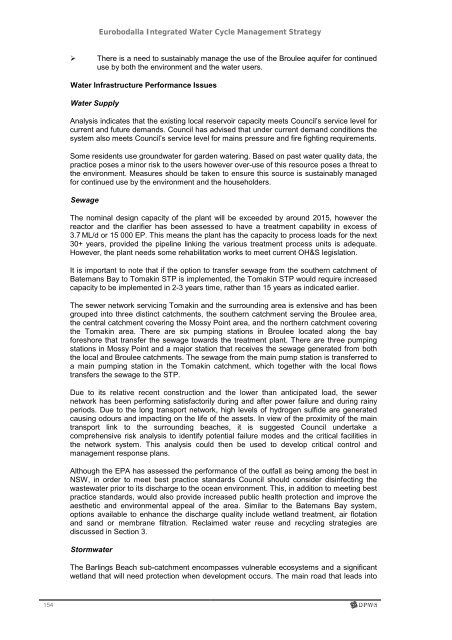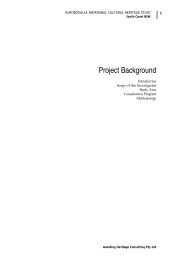Eurobodalla Integrated Water Cycle Management Strategy
Eurobodalla Integrated Water Cycle Management Strategy
Eurobodalla Integrated Water Cycle Management Strategy
Create successful ePaper yourself
Turn your PDF publications into a flip-book with our unique Google optimized e-Paper software.
154<br />
<strong>Eurobodalla</strong> <strong>Integrated</strong> <strong>Water</strong> <strong>Cycle</strong> <strong>Management</strong> <strong>Strategy</strong><br />
There is a need to sustainably manage the use of the Broulee aquifer for continued<br />
use by both the environment and the water users.<br />
<strong>Water</strong> Infrastructure Performance Issues<br />
<strong>Water</strong> Supply<br />
Analysis indicates that the existing local reservoir capacity meets Council’s service level for<br />
current and future demands. Council has advised that under current demand conditions the<br />
system also meets Council’s service level for mains pressure and fire fighting requirements.<br />
Some residents use groundwater for garden watering. Based on past water quality data, the<br />
practice poses a minor risk to the users however over-use of this resource poses a threat to<br />
the environment. Measures should be taken to ensure this source is sustainably managed<br />
for continued use by the environment and the householders.<br />
Sewage<br />
The nominal design capacity of the plant will be exceeded by around 2015, however the<br />
reactor and the clarifier has been assessed to have a treatment capability in excess of<br />
3.7 ML/d or 15 000 EP. This means the plant has the capacity to process loads for the next<br />
30+ years, provided the pipeline linking the various treatment process units is adequate.<br />
However, the plant needs some rehabilitation works to meet current OH&S legislation.<br />
It is important to note that if the option to transfer sewage from the southern catchment of<br />
Batemans Bay to Tomakin STP is implemented, the Tomakin STP would require increased<br />
capacity to be implemented in 2-3 years time, rather than 15 years as indicated earlier.<br />
The sewer network servicing Tomakin and the surrounding area is extensive and has been<br />
grouped into three distinct catchments, the southern catchment serving the Broulee area,<br />
the central catchment covering the Mossy Point area, and the northern catchment covering<br />
the Tomakin area. There are six pumping stations in Broulee located along the bay<br />
foreshore that transfer the sewage towards the treatment plant. There are three pumping<br />
stations in Mossy Point and a major station that receives the sewage generated from both<br />
the local and Broulee catchments. The sewage from the main pump station is transferred to<br />
a main pumping station in the Tomakin catchment, which together with the local flows<br />
transfers the sewage to the STP.<br />
Due to its relative recent construction and the lower than anticipated load, the sewer<br />
network has been performing satisfactorily during and after power failure and during rainy<br />
periods. Due to the long transport network, high levels of hydrogen sulfide are generated<br />
causing odours and impacting on the life of the assets. In view of the proximity of the main<br />
transport link to the surrounding beaches, it is suggested Council undertake a<br />
comprehensive risk analysis to identify potential failure modes and the critical facilities in<br />
the network system. This analysis could then be used to develop critical control and<br />
management response plans.<br />
Although the EPA has assessed the performance of the outfall as being among the best in<br />
NSW, in order to meet best practice standards Council should consider disinfecting the<br />
wastewater prior to its discharge to the ocean environment. This, in addition to meeting best<br />
practice standards, would also provide increased public health protection and improve the<br />
aesthetic and environmental appeal of the area. Similar to the Batemans Bay system,<br />
options available to enhance the discharge quality include wetland treatment, air flotation<br />
and sand or membrane filtration. Reclaimed water reuse and recycling strategies are<br />
discussed in Section 3.<br />
Stormwater<br />
The Barlings Beach sub-catchment encompasses vulnerable ecosystems and a significant<br />
wetland that will need protection when development occurs. The main road that leads into

















